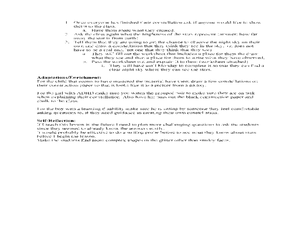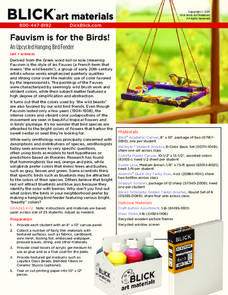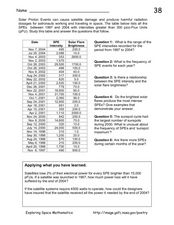Curated OER
Power Functions: A Question of Magnitude
In this power functions worksheet, high schoolers read about determining the brightness of stars using a magnitude scale. Students solve 4 problems including finding the magnitude differences of stars and determining equivalent magnitudes.
Curated OER
How is a Star's Color Related to Its Temperature?
For this star color and temperature worksheet, learners create a Hertzsprung-Russell diagram in order to determine how star brightness, color, temperature, and class are related. Once diagram is complete, they answer 6 short answer...
Curated OER
Size of Stars
Fifth graders draw constellations in the sky and use the brightness levels of stars to show how big they are. In this constellations lesson plan, 5th graders describe what they see in the night sky by discussing the star's distances.
Curated OER
Keeping Spirits Bright
Here are some transition and sponge activities to keep your students motivated until winter break.
Curated OER
Look on the Bright Side!
Students explore solar eclipses by participating in a number of hands-on activities. In class, students work in teams using tennis balls, grapes and flashlights to model partial and total solar eclipses.
Curated OER
Light and Dark
For this recognizing things that provide light worksheet, students cut out only the pictures that give off light and paste them in order from brightest to least bright. Students show 4 answers.
Curated OER
The Hertzsprung-Russell Diagram
In this astronomy worksheet, students use a Hertzsprung-Russell diagram to examine the relationship between the average temperatures of stars and their absolute magnitude. After viewing the diagram, they complete 10 short answer questions.
Curated OER
Module 2: "Keeping Teeth Bright and Healthy"
Learners become aware why cleaning their teeth helps keep them strong and healthy. They study basic brushing techniques, what plaque is, how a cavity is formed, why having clean teeth is an important part of having a clean body and why...
Curated OER
Incomplete Dominant and Codominant Traits Worksheet
A two-page instructional activity provides seven Punnett squares for practice in determining genotypes and phenotypes. Each is an example of incomplete dominance or codominance. After your bright biologists have mastered Punnett squares,...
Curated OER
Alphabet Forwards and Backwards
The alphabet is largely displayed from beginning to end, then end to beginning in this bright PowerPoint. Each slide contains the upper and lower case letters from A to Z. This is a great tool to use when teaching the alphabet. Tip: You...
Curated OER
Simetria
Your Spanish students will see what symmetry looks like on a quadrilateral, triangle, and circle in this presentation. Large, bright shapes are displayed with lines of symmetry, followed by examples that do not show a line of symmetry....
Scholastic
Study Jams! Plant Adaptations
Mia video chats with Sam from Hawaii! They talk about plant adaptations that allow them to live in particular environments. Examples include the flexible stems and leaves, or floating seeds and flowers of aquatic plants. The adaptive...
Baylor College
Fuel for Living Things
During a three-part lesson, learners make a cabbage juice pH indicator and use it to analyze the waste products of yeast after feeding them with sugar. The intent is to demonstrate how living organisms produce carbon dioxide, which is...
Curated OER
Math in English Skills X Exercise Book
Provide your remedial math learners with a handy packet that will help them practice prime factorization, exponents and roots, and multiplication and division of fractions. The packet includes 20 pages, bright images, and answer keys....
Blogger
Problem Solving Strategies
Eight mini-posters remind your math class of strategies to try when attacking a problem. Print each one on a different brightly colored piece of paper, laminate, and post in your classroom for year-long reference. Strategies...
Curated OER
Constellations
Students investigate the concept of the constellations using many different resources to find information. Then students use the information in order to construct models of the constellations that show the magnitude of their size and...
NASA
Discovering Some of Your “Yardsticks” Are Actually “Meter-sticks”
The Milky Way gets great reviews on Trip Advisor — 100 million stars. The activity allows scholars to rethink their assumptions and prior knowledge. Pupils observe a set of two lights at equal distance and brightness, but they believe...
Dick Blick Art Materials
Fauvism is for the Birds!
Here's a art project that lets kids use bold colors to express their inner wild beasts, and maybe even attract a few wild birds. Using old picture frames, canvases, and screen mesh, young fauvists craft bird feeders and decorate their...
Curated OER
Solar Proton Events
On this worksheet, space scientists use a data table to answer questions about the relationship between the brightness of solar flares and the intensity of the solar proton events. They apply what they learned from the data to address...
Curated OER
SIZING UP SOL
Ninth graders produce a projected, pinhole image of the sun and from measurement of the image and projection distance, calculate the actual size of the sun. They estimate the sun's apparent brightness from different planet.
Perkins School for the Blind
Beanbag Toss
Why is learning how to catch and toss so important? If one has visual impairments, learning this basic skill will help him increase orientation and mobility, coordination, and cognitive development,. Mastery of this skill will also mean...
NASA
Just How Far is That Star?
Pupils often wonder how we know the distance to various stars. Starting with a thought experiment and progressing to a physical experiment, they determine the brightness and distance to various stars. The evaluation requires critical...
Colorado State University
How Can You Demonstrate the Different Efficiencies of Different Light Bulbs?
Need a bright idea for an engaging lab? Watch your class light up as they explore the difference in efficiency between incandescent and LED bulbs! The resource makes use of simple materials and encourages learners to infer what's...
Glynn County School System
Lives and Deaths of Stars
Star light, star bright ... just how long can you wish on that star? Well, it depends on its mass. The presentation explains the life cycle of stars based on their sizes. Scholars learn about the life expectancy of a star based on the...
Other popular searches
- Bulb Brightness
- Brightness of Stars
- Star Brightness
- Brightness and Light
- Stars Brightness
- Star Color Brightness
- Rating Star Brightness
- Stellar Brightness
- Stars Distance Brightness
- Luminosity and Brightness
- Star Brightness Game
- Stars Brightness Game

























